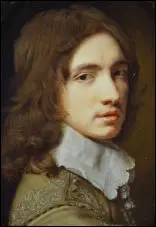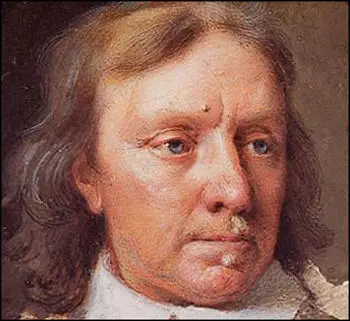Samuel Cooper

Samuel Cooper, the eldest child of Richard Cooper and Barbara Hoskins, was probably born in London in about 1608. After studying painting under his uncle, John Hoskins, he travelled around Europe. (1) According to Samuel Pepys, during this period he learnt to to speak French. (2)
In 1642 Cooper married Christiana Turner (1623–1693). In 1650 Cooper moved with his wife to one of the most substantial houses in Henrietta Street, in Covent Garden. There were no children of the marriage. (3)
During the English Civil War Cooper established himself as a portrait painter, who only worked in miniatures. (4) He painted several "portraits of men in armour usually against a dark background". This included paintings of John Milton, George Monck, John Pym, Henry Ireton, Robert Lilburne and John Carew. (5)
Cooper's first portrait of Oliver Cromwell was painted in 1649. Cromwell selected artists like Cooper who would present him "plain both in character and in clothing". It has been pointed out that plainness had a political purpose, presenting Cromwell as a "sober, honest alternative to the tradition of royal vanity, excess and arrogance he’d just replaced". (6) Alfred L. Rouse argues that "Cooper rendered the finest portrait of the great man, painted with penetrating sense of character." (7)
Cromwell once told the artist, Peter Lely to "use all your skill to paint my picture truly like me and not flatter me at all. Remark all these roughness, pimples, warts and everything as you see me. Otherwise I’ll never pay a farthing for it." (8) Cooper obviously followed the same instructions and it seems that he was responsible for more paintings of Cromwell than any other artist. (9)

Cooper was commissioned to paint members of Cromwell's family, including his son, Richard Cromwell. However, this did not stop him being employed by Charles II upon his acquisition to the throne in 1660. Cooper was also called upon to paint miniature portraits of his mistresses and children. (10)
In January 1662, Cooper was chosen to provide the art work of the King for a profile for the new coinage. John Evelyn was present when it was carried out. "I was called to his Majesty's closet when Mr. Cooper, the rare limner, was crayoning of the King's face and head, to make the stamps by, for the new milled money now contriving, I had the honour to hold the candle whilst it was doing, he choosing the night and candle-light for the better finding out the shadows. During this his Majesty discoursed with me on several things relating to painting and graving." (11)
Cooper's biographer, John Murdoch, argues that his portrait of James, the Duke of York, in 1661 "is an excellent example of the development in his orthodox miniature portraiture at this period. It is bright and direct in its lighting, and subtly enriched in its representation of the sitter's complexion." In 1663 Cooper was appointed as king's limner. (12)
Samuel Cooper died on 5th May, 1672.
Primary Sources
(1) John Murdoch, Samuel Cooper : Oxford Dictionary of National Biography (2004-2014)
By the mid-1640s he (Samuel Cooper) was adapting himself and his style successfully to suit the prevailing conditions of patronage in London during the civil wars and interregnum, building a reputation for good likenesses, brilliant execution, and great personal charm. His ‘parliamentary’ output - portraits of men in armour usually against a dark background, and women whose tenue remained relatively unaffected by the circumstances of war - culminated in the paintings of Oliver Cromwell in the early 1650s...
Cooper seems to have taken various likenesses of Cromwell for various purposes, including formal portraiture, for which he made the ad vivum sketch now in the collection of the duke of Buccleuch and on which Lely may have relied for the surviving oil painting. There are also images made apparently for use on medals or coins, a good example of which is an ad vivum profile in the National Portrait Gallery.
(2) Melisa Thomas, Samuel Cooper Portrays Oliver Cromwell's Warts and All (6th December, 2013)
The intriguing exhibition at 29 Dover Street, Warts & All takes its title from Oliver Cromwell’s controversial request to be painted realistically as opposed to idealistically.
The exhibition features several seventeenth-century miniature paintings, mainly by Samuel Cooper, who famously painted Cromwell with the prominent wart on his forehead, credited as “Britain’s first internationally celebrated artist”.
Upon entering the gallery, you’re invited to pick up a magnifying glass with which to study the miniatures. If you look towards the end of the room you can see Sir Peter Lely’s famous painting of Oliver Cromwell and Cromwell’s death mask.
But before you reach these there are a number of miniatures to examine, and each artwork has been annotated with interesting historical and technical information...
Unsurprisingly, the miniatures of Cromwell (including Cooper’s version (c. 1653) complete with the notorious wart) feature by the side of the Lely portrait and death mask of Cromwell at the end of the room.
The second room explains that not only was Cooper commissioned to paint Cromwell and his family in the early 1650s, he was later chosen by Charles II upon his acquisition to the throne in 1660. Cooper was called upon to paint miniature portraits of Charles II, as well as his mistresses and children, as part of the King’s endeavours to establish power and influence during the Restoration period.
(3) Alastair Smart, The Daily Telegraph (11th October, 2014)
Charles II’s propagandists cast Cromwell as a brutal despot who’d dispatched testy civilians at will, most notoriously all the Irish Catholics at the Wexford and Drogheda massacres of 1649. Nowadays critics tend to focus on his Puritan fundamentalism, which outlawed the celebration of Christmas. This, apparently, was a dour, austere man – who censored playwrights, disdained culture and showed no interest at all in the visual arts.
Certainly he had no official painter, and portraits of Cromwell are few and far between. The most famous is by Robert Walker, from 1649, in the National Portrait Gallery: a proud, if shaggy-haired, figure in cuirassier armour, holding a baton of authority in his hand.
The image is clearly inspired by the poses in aristocratic portraits by van Dyck – Walker’s predecessor and superior, who died before the outbreak of Civil War, in 1641 – specifically his paintings of Sir Kenelm Digby and Sir Edmund Verney.
Insofar as it existed at all, Cromwellian portraiture, it seems, was merely an extension of portraiture under Charles I.
Peter Lely and miniaturist Samuel Cooper were others who depicted him, but Cromwell’s attitude to his own image is summed up by his request to Lely to "use all your skill to paint my picture truly like me and not flatter me at all. Remark all these ruffness, pimples, warts and everything as you see me. Otherwise I’ll never pay a farthing for it." (This, slightly modified, is the origin of the expression "warts and all".)Lely duly captured Cromwell in sober black armour, without a hint of decoration. And with the receding hairline and blotchy cheeks – not to mention, pronounced wart on his chin – Cooper rendered Cromwell most candidly of all.
There might be more to these portraits than meets the eye, however, if another of Cromwell’s famous quotes is anything to go by. In the New Model Army, he said he’d “rather have a plain, russet-coated captain that knows what he fights for… than that you call a Gentleman and is nothing else.” In other words, he chose soldiers on merit not class.
The broad meaning of the word “plain” is key here. Cromwell sought men who were plain both in character (ie, pious) and in clothing too. Plainness thus had a political purpose, presenting Cromwell as a sober, honest alternative to the tradition of royal vanity, excess and arrogance he’d just replaced.
Sir Philip Warwick recalled, the first time they met, that Cromwell wore a “plain-cloth sute, which seemed to have bin made by an ill country-taylor; his linen plain and not very clean”.
Is it possible then, that warts-and-all portraiture was very deliberately adopted rather than a product of indifference? Part of a plain-style aesthetic to reflect a plain-style politics, refuting any notion that Cromwell had lofty monarchical aims in the process?
(4) Maev Kennedy, The Guardian (8th November, 2013)
Samuel Cooper was regarded as the best portrait painter of his day, but only worked in miniatures. The Cromwell is best known from a full-size version painted by Peter Lely, where the wart appears as a mere smudge over the Lord Protector's right eyebrow. The face in Cooper's original, in watercolour on vellum, is the size of a 50p piece but miraculously detailed – from the bald patch, creased forehead and roughened cheeks to the jowly five o'clock shadow.Cooper had painted an earlier portrait of Cromwell soon after he came to power, in which he appears almost Botoxed, the face longer and more conventionally noble. When Cromwell came to his London studio – Cooper demanded that his clients, even royalty, come for an extraordinary eight sittings – he gave the famous order for less flattery and more accuracy.
"It is the best painted wart in English art, if not the only painted wart in English art," Bendor Grosvenor, head of research at the gallery, said. "When you see it close up in high definition the top is all white and flaky, absolutely repulsive."
When Cromwell died his son came to the studio to buy the sketch: Cooper's usual price was £20, but he demanded and got £100.
Student Activities
Portraits of Oliver Cromwell (Answer Commentary)

